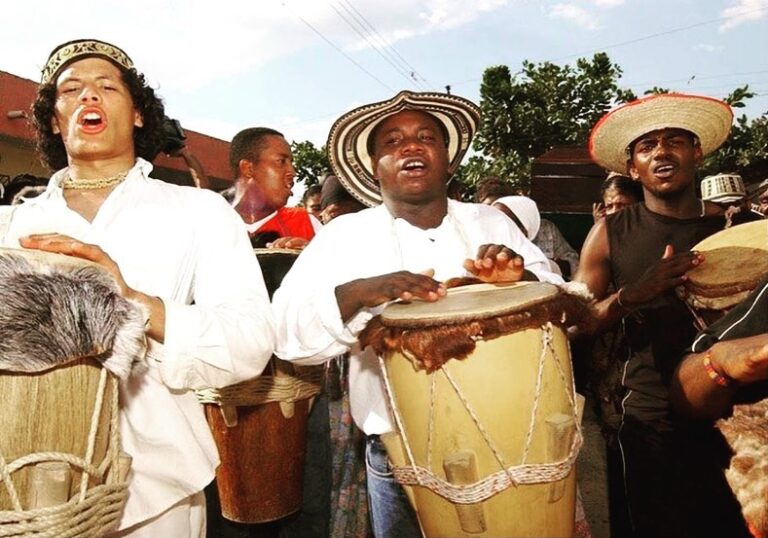Explore and bring up. Recover and preserve. Support and spread. Tracing roots music today involves several actions, especially if it is in Colombian territory, where more than 1,000 rhythms have emerged, distributed in more than 150 music genres. There’s a great diversity of sounds that identify the five regions of Colombia with well-defined cultures: the Caribbean, the Andean, the Pacific, the Orinoquía and the Amazon.
Of course, digging into these roots also means going back again and again to cumbia. This ever-present and successful genre serves as the gateway to this wonderful and vast musical universe. In its most primitive form, cumbia brings together the three main Colombian cultural influences: indigenous (wind and percussion instruments), African (rhythm and dance) and European (Spanish song and poetry adapted by the local people). Cumbia is heard and danced throughout Colombia, and each region does it in its own way, coexisting and conversing with other folklore and ancestral sounds.
“Colombia is an endless source of music and expressions,” says the renowned musician, producer and arranger Tato Marenco. “Even the same cumbia can be performed differently in each town on the Caribbean coast. But we have the advantage of sharing some musical codes and formats in the country, such as wind bands and the accordion. Cumbia is played throughout Colombia, it’s our common thread, our mother rhythm.”
Just a month ago, Tato released his new album Mamá Cumbé. Right from the title there’s a clear interest in Colombian roots music, with the talented multi-instrumentalist from Barranquilla willing to pay homage to a mother called “cumbé” (a dance of African origin, etymological reason for the word “cumbia”). Now he’s playing that record live with Los Hijos de Mama Cumbé. “This band is a mixture where the ancestral sounds of the Colombian Atlantic coast prevail along with elements of the Caribbean,” he explains. “We approach a sound that’s also tropical, especially from the brass, influenced by Lucho Bermúdez, Pacho Galán and Joe Arroyo. Percussion is the band’s heart, and from there we venture into improvisation and arrangements.”
Marenco played and recorded all kinds of percussion and native instruments, such as the gaita (Colombian bagpipe) and the caña de millo (woodwind flute used mainly in the Caribbean area). That baggage and those credentials allowed him to easily count on local living legends such as Totó La Momposina, Petrona Martínez and Los Gaiteros de San Jacinto for his album. “My first instrument was claves, that was the key that led me to study percussion and Caribbean rhythms,” recalls Tato. “I was born in Barranquilla, where we have the biggest party in Colombia when it’s Carnival. And the millo is the main instrument of that region. I always had an easy time adapting to wind instruments, such as the gaita and the clarinet. All of this helped me later when I started touring with Totó, since multi-instrumentalists were needed to play porros, fandangos, cumbias.”
With a legacy of nearly 80 years, carefully transmitting their music from one generation to the next, Los Gaiteros de San Jacinto are the guardians of one of the greatest treasures of Colombian folklore. They’re also one of the jewels in the catalog of Llorona Records, dedicated to the living rescue of traditional music from the Caribbean, the Pacific and the rural areas of the country. “We are always looking for artists with a unique voice, who have been able to save their own sound and who have an active process,” says Diego Gómez, better known as Cerrero, the Bogotá producer who leads this fascinating label and who even managed to remix Los Gaiteros in the key of dub (Dub de Gaita).
“Our passion leads us to visit the places where a movement is still in force, such as the regional festivals of gaita and marimba music,” explains Diego. “We’re traveling throughout Colombia all year long, looking for the teachers, the composers, sharing with the musicians who are already part of the label and always showing us new music.” Cerrero welcomes the relevance of cumbia – both nationally and internationally – but prefers to venture a little further and move the focus to less explored areas. That’s why he set up another label, Discos Pacífico. “What cumbia has achieved as a movement is impressive, it can only be compared to what was the history of salsa or reggae,” he says. “The music of the Pacific is on that path, but it’s still something to discover for many.”
Released in 2019 by Llorona Records, De Mar y Río by Canalón de Timbiquí is the only album of traditional Pacific music nominated for a Latin Grammy. It’s also the production that prompted Diego to create a more specific geographic label to capture what happens in the region. Previously, in 2015, he had already surveyed the area to conduct an anthropological record of Tamborito Nuquí, an endangered rhythm from northern Choco that is musically connected to Panama. Then he met Nidia Góngora, the most recognized singer in the Colombian Pacific. Diego became her friend and decided to support her with her new folkloric project. “Making this album with Nidia and Canalón was an incredible experience and learning,” he says. “The album was conceived from the idea of understanding marimba music as the voice of the jungle, of caring for the forest, and knowing that it was time for the Pacific to explode and begin to conquer new audiences.”
Diego assures that De Mar y Río was the album that allowed them to “consolidate a working model where each album is the heart of a meeting process to strengthen local regional scenes.” From there Discos Pacífico was born, “a creative laboratory for music from the Colombian Pacific,” according to its creator. “The label has a very clear mission: to be a platform that allows the world to discover the music scene in this region, where we believe the most musically interesting things are happening right now in the country.”


